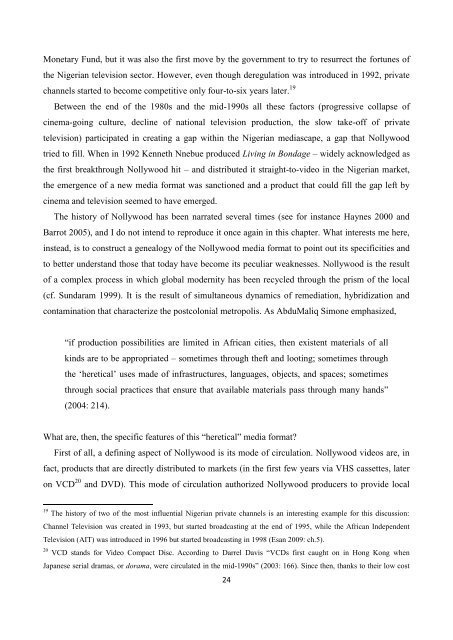You also want an ePaper? Increase the reach of your titles
YUMPU automatically turns print PDFs into web optimized ePapers that Google loves.
Monetary Fund, but it was also the first move by the government to try to resurrect the fortunes ofthe Nigerian television sector. However, even though deregulation was introduced in 1992, privatechannels started to become competitive only four-to-six years later. 19Between the end of the 1980s and the mid-1990s all these factors (progressive collapse ofcinema-going culture, decline of national television production, the slow take-off of privatetelevision) participated in creating a gap within the Nigerian mediascape, a gap that Nollywoodtried to fill. When in 1992 Kenneth Nnebue produced Living in Bondage – widely acknowledged asthe first breakthrough Nollywood hit – and distributed it straight-to-video in the Nigerian market,the emergence of a new media format was sanctioned and a product that could fill the gap left bycinema and television seemed to have emerged.The history of Nollywood has been narrated several times (see for instance Haynes 2000 andBarrot 2005), and I do not intend to reproduce it once again in this chapter. What interests me here,instead, is to construct a genealogy of the Nollywood media format to point out its specificities andto better understand those that today have become its peculiar weaknesses. Nollywood is the resultof a complex process in which global modernity has been recycled through the prism of the local(cf. Sundaram 1999). It is the result of simultaneous dynamics of remediation, hybridization andcontamination that characterize the postcolonial metropolis. As AbduMaliq Simone emphasized,“if production possibilities are limited in African cities, then existent materials of allkinds are to be appropriated – sometimes through theft and looting; sometimes throughthe ‘heretical’ uses made of infrastructures, languages, objects, and spaces; sometimesthrough social practices that ensure that available materials pass through many hands”(2004: 214).What are, then, the specific features of this “heretical” media format?First of all, a defining aspect of Nollywood is its mode of circulation. Nollywood videos are, infact, products that are directly distributed to markets (in the first few years via VHS cassettes, lateron VCD 20 and DVD). This mode of circulation authorized Nollywood producers to provide local19 The history of two of the most influential Nigerian private channels is an interesting example for this discussion:Channel Television was created in 1993, but started broadcasting at the end of 1995, while the African IndependentTelevision (AIT) was introduced in 1996 but started broadcasting in 1998 (Esan 2009: ch.5).20 VCD stands for Video Compact Disc. According to Darrel Davis “VCDs first caught on in Hong Kong whenJapanese serial dramas, or dorama, were circulated in the mid-1990s” (2003: 166). Since then, thanks to their low cost24
















